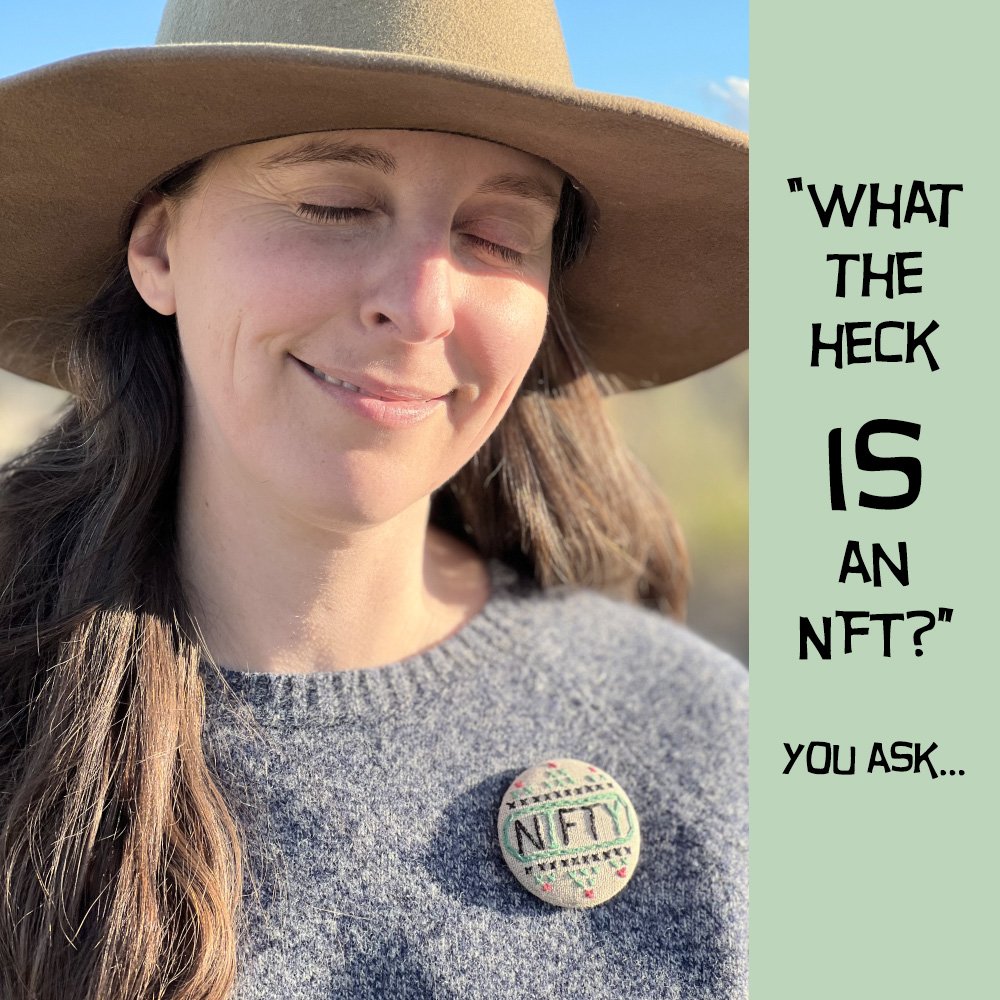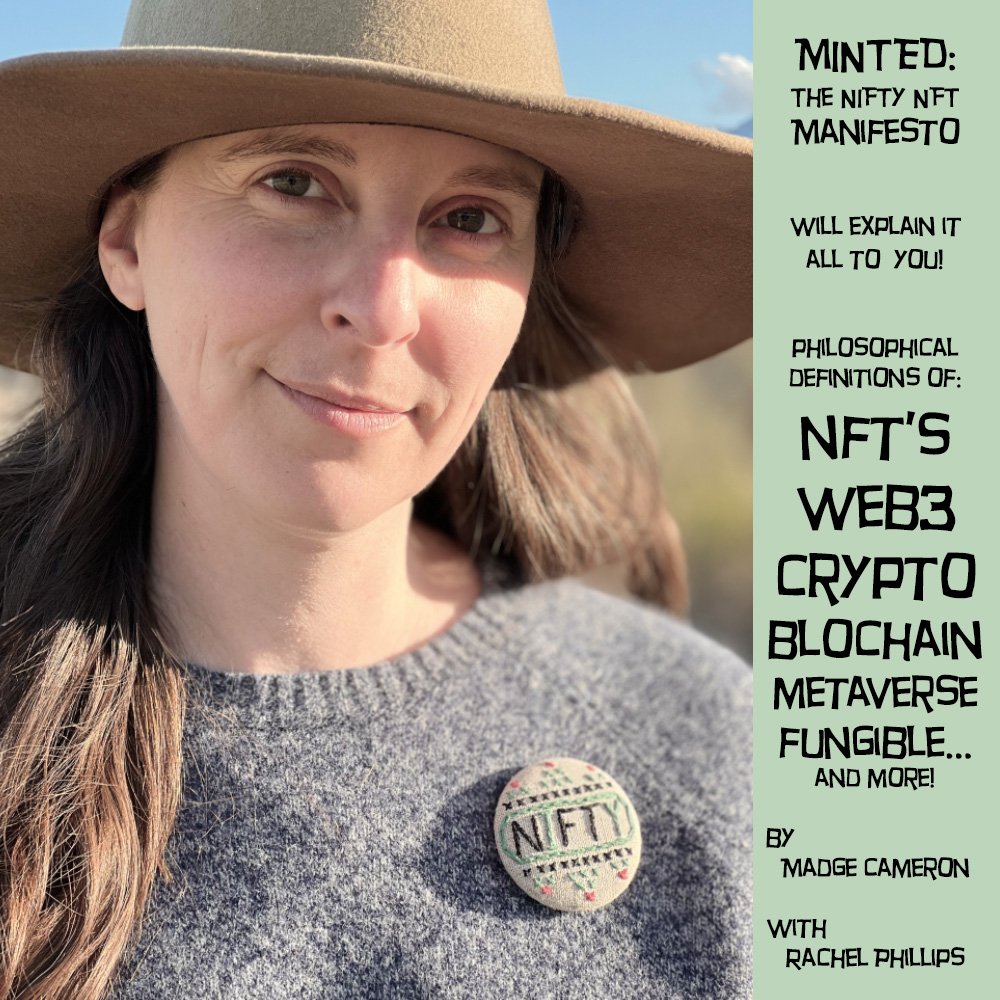Minted: NFT Manifesto
Minted: NFT Manifesto
Minted: The Nifty NFT Manifesto is written in the voice of a fictional aging archivist and librarian named Madge Cameron, who has long struggled to bridge the analog/digital divide. Cameron leads the reader on a trip down the rabbit hole of what she terms “Financialized Web Land” before popping up on the other side with a renewed appreciation for our material world.
Regular Edition of 125 signed copies: $20 + $5 S&H
Special Edition of 18 signed and numbered sets: (SOLD OUT)
Shipping is included in the price displayed when adding to cart
Permanent Holdings: Harvard University, MA; Hirsch Library at the Museum of Fine Arts, Houston, TX; MassArt, Boston, MA; SFMOMA Library + Archives, CA; Smith College, MA; University of Arizona, AZ; University of Colorado Boulder, CO; University of Iowa, IA; University of Miami, FL; University of Minnesota, MN; University of Utah, UT; University of Wisconsin - Madison, WI; Yale University, CT
Institutional acquisitions: for help with purchasing or to place a book on hold, please contact Rachel
REGULAR AND SPECIAL EDITION DETAILS
Writing, photographs, embroidery and design by Rachel Phillips as herself and as alter-ego Madge Cameron.
Regular Edition: risograph printed booklet in four colors on Domtar Cougar Smooth and Legion Colorplan with plant-based inks by Risolve Studio in Lancaster, Pennsylvania. 5x8 inches, 32 pages, saddlestitch binding. 125 signed copies.
Special Edition: booklet plus the Nifty NFT Pin (100% linen with cotton embroidery floss and an American steel pin back assembled in San Francisco). Each hand-embroidered pin is subtly different, and takes Phillips about two hours to stitch. Special edition pin and booklet are housed in an artist-made 100% wool felt sleeve with two pockets. 18 signed and numbered sets.
Published July, 2022 by Treadwell Press in Pacifica, CA.
BOOK
Capitalizing on a boom of cryptocurrency speculation in recent years, artists, major corporations, prestigious galleries, auction houses—and of course fraudsters, grifters and hustlers—have all rushed in to sell NFT’s (uniquely authenticated digital artwork, often of dubious quality). In this atmosphere, discussion of NFT’s in the press, celebrity sphere and social media are often contradictory and sharply divided. Seeking to combat this, Cameron uses Minted to define the basic components of the system in a purposefully gentle and systematic way—including blockchains and cryptocurrency, fungible and non-fungible, NFT’s, the metaverse, Web3 and global warming.
Beyond definitions, Cameron urges us to take a critical foundational look at what it means to understand NFT’s and the blockchain technology required to support them not just as new digital tools, but as a values system that elevates contrived digital scarcity and commodified data over the intrinsically scarce material of our only planet. Cameron considers the challenges as an archivist in preserving both analog and digital materials, drawing correlations and distinctions between the two with regard to the ways in which they are likely to endure (or fail to).
Ultimately, Cameron takes a deeply humanistic approach to Minted, returning to her own physicality as a barometer of the merits of NFT’s. She reminds us that all that glitters is not gold, and that we do well to treasure the world of four dimensions, in all its imperfect flux, over the shining digital city on a hill built of paltry ones and zeros. In this way, Minted aims to simultaneously be a response to our current moment and a message to the future.
The book is richly illustrated with photographs made by Cameron in her inimitable glitchy style using analog source material in her archive, with additional imagery from the public domain.
NIFTY NFT PIN
The subtitle of Minted was inspired by a historic folk art protest pin in Madge Cameron’s archival collection of Early American Cryptographic Embroidery. The Arts & Crafts Nifty NFT (N-i-FT-y) Pin was intended by the stitcher to draw attention to the conceit of digital non-fungibility by being an intrinsically non-fungible object due to its handmade and physical qualities. The Nifty NFT Pin declares itself nifty, celebrates whatever it is affixed to as nifty, and cheers whoever may read it as also being…nifty!
By incorporating a hand-embroidered object into Minted, as well as referencing stitching as a historically “women’s work” method of expression, Cameron intentionally offers a different aesthetic and material representation of Web3 from the prevailing depictions of a sleek, futuristic space dominated by male creators and participants. By using handwork and natural materials to speak to this computerized “space” (a construct), she urges us to consider the mirage of technological promise—of what, and for whom?—more closely.
ABOUT RACHEL PHILLIPS and MADGE CAMERON
Madge Cameron is an alter-ego of artist and writer Rachel Phillips. Her archive is imaginary but her creative work, as completed by Phillips, is real.
Rachel Phillips began photography while completing her undergraduate degree in creative writing at Skidmore College, graduating in 2005. A frequent theme in her work is a desire to “reanimate” the vernacular photographs and paper ephemera in her collection by reworking them in a variety of ways to create imagery that is resonant with the past yet has a new vitality and reflection of our own time and perspective. Her work includes producing unique handmade photographic objects and small edition prints from her studio in Pacifica, CA. Under her imprint Treadwell Press, she makes artists’ books blending true and fictional narratives, creative writing and photography. Her artist’s books are held in special collections including Cal Poly San Luis Obispo, University of Iowa, MassArts, Mills College, San Diego State University, Swarthmore College, Texas Women’s University and Yale University.
Madge Cameron is an aging archivist at a private library and collection in San Francisco, a post she has held for many decades. While working to digitize the collection’s extensive photographic holdings beginning in 2013, Cameron discovered accidentally that by moving the photograph while the scan was being recorded, she could separate the image into its color channels, resulting in a strange 3D-esque effect. Since 2013, Cameron has continued to digitize parts of the archive in her idiosyncratic way. Although these scans are failures when viewed as an attempt to make a faithful digital record of the paper original, they provoke us into considering the challenges of translating between analog and digital, asking us to reflect upon the unique attributes, good and bad, of each.









